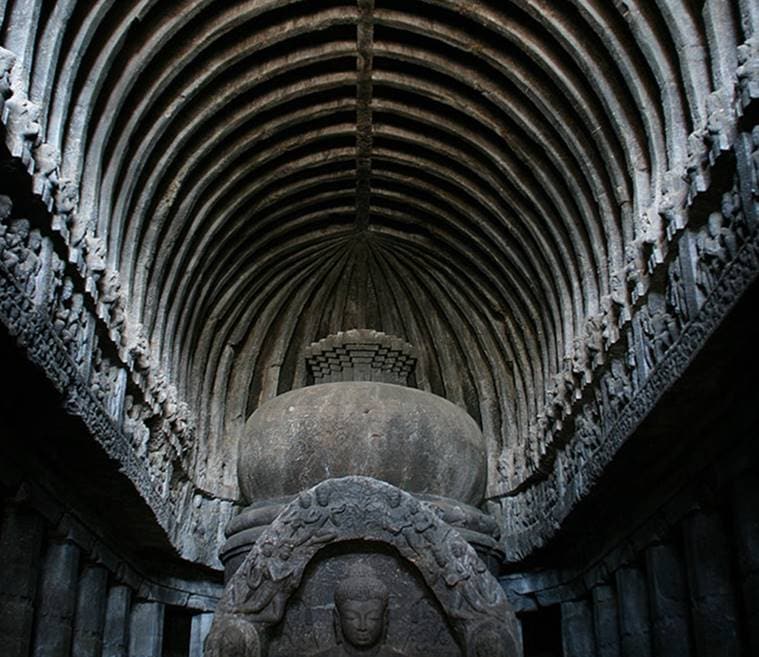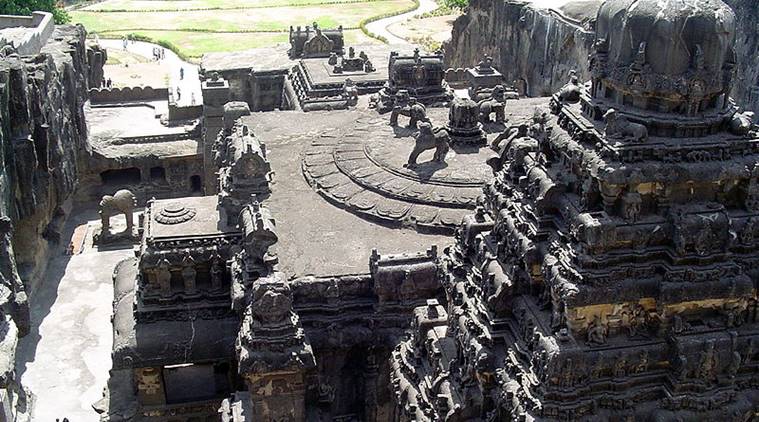The Extraordinary Caves of Ellora: How to carve a mountain
The Ellora caves are uniquely Indian, where temples and monasteries of three major Indian religions, Hinduism, Buddhism and Jainism all nestle together. In ancient India, religious overlap was natural and commonplace.
 A southeast view of Kailasnath temple from Il Costume Antico e Moderno (Source: Giulio Ferrario/Wikimedia Commons)
A southeast view of Kailasnath temple from Il Costume Antico e Moderno (Source: Giulio Ferrario/Wikimedia Commons)
(This is part of the series Make History Fun Again, where the writers introduce historical facts, events and personalities in a fun way for parents to start a conversation with their kids.)
By Archana Garodia Gupta and Shruti Garodia
We always think of the Ellora caves as an afterthought – “Ajanta AND Ellora” – rather than a unique Indian architectural marvel that must be visited on its own merits. Found in the Western Ghats some 30 kilometres from the Maharashtrian city of Aurangabad, the Ellora site is something to behold, with more than 100 rock-cut caves and temples carved painstakingly by hand out of the mountainside; over 600-1000 CE by four different dynasties!
Religion, Indian style
The Ellora caves are uniquely Indian, where temples and monasteries of three major Indian religions, Hinduism, Buddhism and Jainism all nestle together. In ancient India, religious overlap was natural and commonplace. Successive dynasties ruling over the same area often had varying beliefs, but even members of the same family could follow different religions. It sometimes happened that a king could be a staunch Jain, while his wife was devoted to Shiva and his son to the Buddha (or some other combination!). This didn’t cause any conflict, and didn’t stop the royals from funding elaborate religious monuments for all faiths.
 Aurangabad Ellora Caves (Source: Dan Lundberg/Wikimedia Commons)
Aurangabad Ellora Caves (Source: Dan Lundberg/Wikimedia Commons)
At Ellora, the oldest buildings are some early Hindu caves. Then came the Buddhist caves built by the Chalukyas in the 7th century, followed by magnificent Hindu and Jain caves sponsored by the mighty Rashtrakutas (who incidentally conquered lands right up to Kannuaj in North India). These were followed by more Jain caves in the 9th and 10th centuries.
Rock-cut architecture
What is truly extraordinary about Ellora is that each statue and pillar has been carved and excavated out of pure solid stone, rather than being placed there! The rock-cut structures started off by being hewn into the sides of mountains, but gradually the techniques improved so dramatically, that freestanding statues and buildings were able to be carved out.
 Ellora Caves (Source: Soumitra Inamdar/Wikimedia Commons)
Ellora Caves (Source: Soumitra Inamdar/Wikimedia Commons)
Stone carving is notoriously difficult, with no room for mistakes. This is especially true for basalt, the ancient volcanic stone of the Deccan Plateau, which is a hard stone, and so even trickier to work with.
 Kailasha temple at Ellora (Source: Pratheepps/Wikimedia Commons)
Kailasha temple at Ellora (Source: Pratheepps/Wikimedia Commons)
The Kailasha Temple
The crowning glory of the Ellora caves is the Hindu Kailasha Temple. At 32m high, 100m long and 75m wide, it is the largest monolithic temple in India. That is, it has not been built up with stones, like most other famous Hindu temples. Rather, the entire temple has been carved out of one single massive stone!
We think of most temples and buildings being built from the bottom up, one layer at a time. Amazingly, the Kailasha temple was carved from the top down, which meant about 200,000 tonnes of rock were chiselled away over 25 years!
Sculptors started with a massive vertical cliff-face, gradually hollowed out the ceiling and worked their way down, carving out pillars to support the massive weight of the stone ceiling. The architects would have had to calculate and plan painstakingly and precisely; one mistake and the whole thing would have been ruined. Imagine the pressure on them to get it right the first time!
In fact, the Kailasha Temple is such an extraordinary accomplishment, there are various conspiracy theories floating around the internet that it was built by aliens!
Watch the carving of a statue
(For more fun journeys through India’s history, check out the recently released two-volume set, The History of India for Children Vol. 1 and Vol. 2, published by Hachette India. Follow on twitter @shrutigarodia_)


- 01
- 02
- 03
- 04
- 05





























